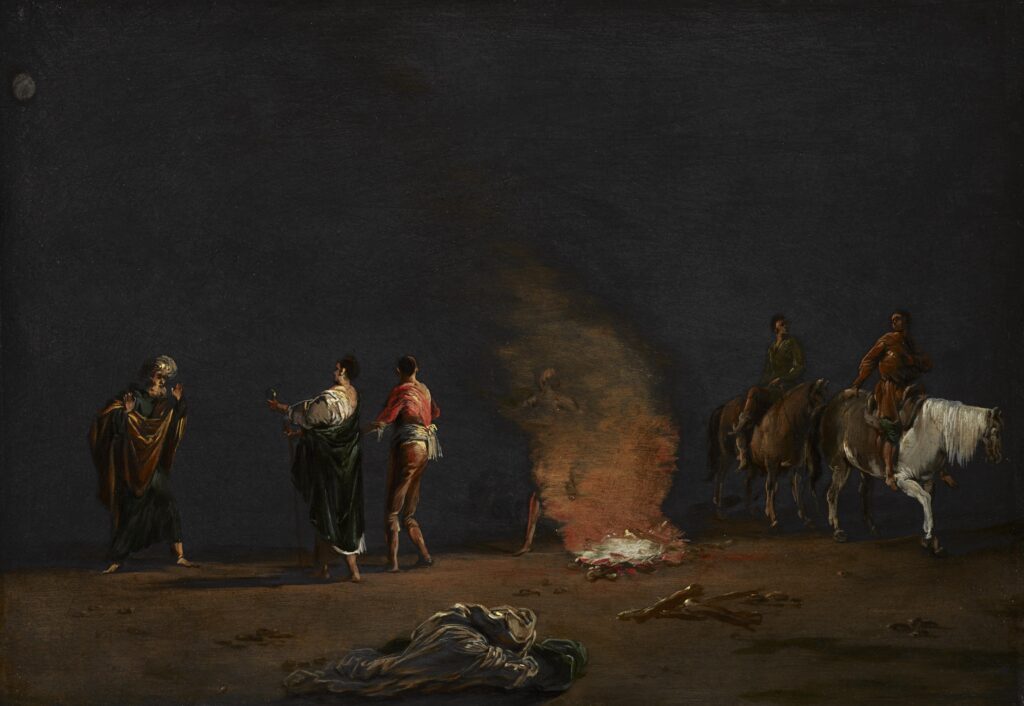Leonard Bramer
1596 - 1674
Judah and Tamar

Essay:
This painting is a typical work by Leonard Bramer. It was probably during the 8 years he spent in Rome that Bramer encountered painting on stone, coming into contact with artists from Verona, such as Alessandro Turchi, who were producing small-scale works on slate in the Eternal city at this time.
In the catalogue of the 2022 exhibition Paintings on Stone: Science and the Sacred 1530‑1580, Judy Mann (p. 126 and fn. 6) records that over 50 small paintings on slate have been attributed to Bramer, most of which are genre scenes or biblical themes. The subject of the present work is not immediately apparent: it may simply be a group of people gathered around a fire, but the turbaned man on the far left who is seemingly being offered something by the figure in green may refer to some as-yet unidentified biblical scene. Alternatively, it may depict a scene with brigands ambushing the turbaned male, his hands raised in surrender. Such subjects were popular with the Dutch artist Pieter van Laer, who arrived in Rome in 1625, as well as the northern followers of Caravaggio.
Many of Bramer’s works on slate are night scenes in which the artist explores the play of reflected light from a source within the painting. In the present work, the campfire plays this role, its rays selectively catching and defining the most important elements of the composition. In this regard, it recalls the atmospheric nocturnal scenes of the Bassano family in the north of Italy. Of particular note here is the rendering of the figure behind the fire, her left leg reflecting the heat of the flames while her back is faintly described through the rising smoke. Our work can be compared to other paintings by Bramer on slate, among them Adoration of the Magi (Gallerie Fiorentine, Florence, inv. no. 830), Herdsmen by a fire (Kremer Collection) and Shepherds near a campfire (ex-Finarte, Milan, 17 December 1987, lot 34), all reproduced in the exhibition catalogue 'Leonaert Bramer 1596‑1674: Ingenious Painter and Draughtsman in Rome and Delft' (Zwolle, 1994, respectively nos. 8, 13 and 13b). The brushwork used to paint the horse in the Adoration scene is particularly close to the white steed in the present picture.
The book of Genesis, (the first book both of the Hebrew Bible and the Christian Old Testament), tells the story of Judah and Tamar. Tamar was married to Er, the eldest son of Judah. God killed Er for not wanting to produce any children. According to Levirate Law, if a man died and his wife had not yet had a child by him, she could demand that his brother marry her and give her a child, who would inherit the name and property of her dead husband. Onan, the second boy in Judah's blood line, duly married his sister-in-law, but refused to fulfil his obligation to produce an heir for his brother. In punishment for this, God killed him too.
Judah, now fearful of losing his third and last son, Shelah, claimed that the boy was still too young to marry and instead abolished his daughter-in-law to her family in Canaan. even when Shelah was old enough for marriage, they omitted to send for Tamar. Thus thwarted and childless, Tamar took matters into her own hand, disguised herself as a prostitute and offered herself to her newly widowed father-in law. Judah willingly accepted and even gave his most important assets, his staff, cord and seal, to the mysterious veiled woman as pledge that he would marry her.
Three months later, word reached the unsuspecting Judah that his daughter-in-law had become pregnant out of wedlock. Enraged, he ordered her to be burned to death for her promiscuity. However, at the crucial moment Tamar, producing the pledges, announced that she was "pregnant by the man to whom these items belong".
In his highly creative and ingeniously concise depiction, Bramer has used continual representation to include several stages of the story while, interestingly, still allowing the figures to react to events across time and space. From right to left, we see: 1. Tamar arriving on horseback from Canaan for her execution; 2. Tamar stripped naked and standing by the fire, her garments lying in a pile in the foreground; 3. Tamar (now dressed) showing the cord, seal and staff to Judah, who recoils in horror at the realisation of his involvement. By the side of Tamar is a young man, possibly the youngest son Shelah, whom Judah did not want her to marry.
Provenance:
Schuler Auktionen, Zurich, 7 May 2001, lot 5159.
Galerie Canesso, Paris.
An important Swedish private collection, acquired from the above in December 2001.